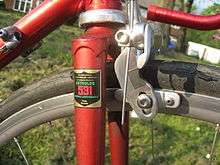Reynolds Cycle Technology
Reynolds Cycle Technology is a manufacturer of tubing for bicycle frames and other bicycle components based in Birmingham, England established in 1898.


History
The Reynolds Tube Company was founded in 1889 by John Reynolds in Birmingham, England,[1] but traces its origins back to 1841 when John Reynolds set up a company manufacturing nails. In 1897, the company patented the process for making butted tubes,[2] which are thicker at the ends than in the middle, this allowed frame builders to create frames that were both strong and lightweight. Reynolds introduced the double-butted tube-set 531 in 1934.[1]
The Patent Butted Tube Co., Ltd., the predecessor of the present company, was spun off from John Reynold's original company in 1898. In 1923 the Patent Butted Tube Co., Ltd changed its name to Reynolds Tube Co., Ltd. and retained this name up until 1928 when it was acquired by Tube Investments, Ltd and became TI Reynolds 531 Ltd.
In 1996 Coyote Sports Inc., a privately held company based in Boulder, Colorado acquired TI Reynolds 531 Ltd. resulting in a name change to Reynolds Cycle Technology Ltd. In 2006 the company underwent another name change to Reynolds Technology Ltd., reflecting the increasing revenues from diversification into "new" sectors for tubing outside the cycle industry.
When Coyote Sports entered Chapter 11 reorganization, a management buy-out resulted in the company returning to its base in the UK.
Cycle tubing development
Reynolds has over the years developed a number of steel alloys, most notably Reynolds 531, which has a high strength and can be made into strong, but lightweight tubes for bicycle frames. Before the introduction of more exotic materials such as aluminium, titanium or composites, Reynolds was considered the dominant maker of high end materials for bicycle frames. According to the company, 27 winners of the Tour de France have won riding on Reynolds tubing. The Raleigh Bicycle Company of Nottingham, England was a big customer for Reynolds 531 tubing used in their racing cycle range.
Reynolds 531 has now been largely replaced in new frames by still-better steels. The latest, for race or sports frames, is Reynolds 953.[3] Reynolds worked closely with Carpenter Speciality Alloys to develop 953. It started reaching frame builders in 2005.[4] 953 is based on a specially developed maraging steel stainless steel alloy that can achieve a tensile strength in excess of 2000 MPa (853 is around 1400 MPa), giving a good strength-to-weight ratio. Because of the high strength of the steel, extremely thin tube walls (down to 0.3 mm) can be used, thus reducing the weight.[5]
Composites
A U.S. division called Reynolds Composites was created to manufacture composite components.
Tubing types
Steel
- 453 - Iron/Manganese/Titanium alloy. Reynolds produced only the 3 main tubes in this alloy and they were single butted.
- SMS - Plain gauge (0.8mm) drawn tubeset in high tensile steel.[6] Replaced 531 plain gauge in 1980, replaced by 500/501 series.
- 500 - A chromium-molybdenum (CrMo) steel, seamed, plain gauge tubeset of 3 main triangle tubes
- 500ATB - Mountain, All terrain, Off road
- 500 Magnum - Same use as ATB
- 501 - Reynolds 501 was a chromium-molybdenum (CrMo) steel, seamed, butted 3-tubes tubeset that made its debut about 1983 and was available in two different thicknesses.
- 501ATB - Mountain, All terrain, Off road
- 501 Magnum - Same use as ATB
- 501SB - Single Butted
- 501SL - Special lightweight (SL) tubeset
- K2 - Reynolds K2 was a chromium-molybdenum (CrMo) steel similar to 501, seamed, butted tubeset, with eight laterally aligned ribs on the butt section, designed and produced exclusively for Raleigh between about 1993 and 1995[7]
- Optima - A chromium-molybdenum (CrMo) steel, seamed, butted tubeset designed and produced exclusively for Raleigh from 1995. Similar to 501 but tweaked for tig welding.[7]
- 520 - Cold worked CrMo. UTS: 700-900 MPa, density 7.78 g/cm3 8 tube set
- 525 - Cold worked CrMo. UTS: 700-900 MPa, density 7.78 g/cm3 8 tube set
- 525Triathlon - Designed for Triathlon framesets
- 531 - Manganese/Molybdenum. UTS: 700-900 MPa (48-58 Tsi, 100-130 ksi), density 7.85 g/cm3
- 531ATB - Designed for Mountain, All terrain, Off road
- 531C - Competition Racing tubeset. Road racing, track, time trial and cyclo-cross. main tubes were 8/5/8 double butted slightly thinner than columbus SL
- 531CS - Club Sport. Double butted 531 main tubes, 501 forks and stays.
- 531Magnum - Oversize, heavy gauge tubeset for use in ATB's.
- 531OS - Oversize tubeset
- 531 Professional - Superseded 531SL, for road racing and time trials. Comprises 531 lightweight main tubes and rear stays.
- 531SL - Special lightweight (SL) tubeset, comprising 531 main tubes drawn thinner than standard 531. Latterly named 531Pro.
- 531 Speed Stream - 531SL Oval shaped aerodynamic tube
- 531ST - Special Touring tubeset[8]
- 531 Super Tourist - Superseded ST.
- 531DS Designer select tubing. Alternative 531 tubes with differing gauges and profiles were available to the specialist builder.
- 631 - Seamless air-hardened. UTS: 800-900 MPa, density 7.78 g/cm3
- 631OS - Oversize tubeset
- 653 - Was a mixed tubeset which superseded 531 Professional and combined tubings of different steels; steering tube and fork 802N/mm2, top, down and seat tube 925N/mm2 and rear triangle 1315N/mm2.
- 708 - 708 was a tube set in Reynolds' range in the 1980s. It has main tubes with special section. These were not butted, but had 8 flats running along the length of the tube. The rear stays would be 753.
- 725 - Heat-Treated CrMo, the same basic alloy as Reynolds 520, but with characteristics like 753. UTS: 1080-1280 MPa, density 7.78 g/cm3
- 725OS - Oversize tubeset
- 731 - Needs information
- 731OS - Oversize tubeset introduced in 1992 double butted oversized tubes with laterally aligned stiffening ribs on the but sections to maximize stiffness and torsional rigidity. Tubeset: Strength steering tube and fork 802N/mm2, top, down and seat tube 925N/mm2 and rear triangle 1315N/mm2. [9]
- 753 - Heat-Treated Manganese-Molybdenum. The most exclusive tube set from Reynolds. Essentially 531 made with reduced wall thickness and heat treated to increase tensile strength. UTS: 1080-1280 MPa (70-83 Tsi, 157-186 ksi) Complete tube set of 11 tubes (Frame 8, Fork 3). 753 can only be lugged and fillet-brazed with an alloy of 56% silver below 700 degrees Celsius and sale is restricted only to approved builders certified by Reynolds
- 753ATB - Mountain, All terrain, Off road
- 753R - Road tubeset
- 753T - Track tubeset, thinner tubes for track use
- 753OS - Oversize tubeset
- 853 - Seamless air-hardening heat-treated. UTS: 1250-1400 MPa, density 7.78 g/cm3
- 853OS - Oversize tubeset
- 921 - Cold-work stainless steel
- 931 - Precipitation hardening stainless steel. Tubing introduced in 2012. Can be used with 953 to reduce overall frame costs.
- 953 - Maraging stainless steel. Introduced in 2005. UTS: 1750-2050 MPa, density 7.8 g/cm3
Aluminium
- 7005 - Al-Zn alloy. UTS: 400 MPa, density 2.78 g/cm3
- 6061 - Al-Si-Mg alloy. UTS: 325 MPa, density 2.70 g/cm3
- X-100 - Al-Li Alloy. UTS: 550-600 MPa, density 2.65 g/cm3
Titanium
- 6Al-4V - Seamless ELI Grade. UTS: 900-1150 MPa, density 4.42 g/cm3
- 3Al-2.5V - Seamless. UTS: 810-960 MPa, density 4.48 g/cm3
- CP 2 - Supplied to Raleigh during the 1990s
Magnesium
- MZM Electron - Magnesium Alloy. UTS: ~300 MPa, density ~1.80 g/cm3
See also
References
- 1 2 Herlihy, David V (2004). Bicycle: the History. Yale University Press. p. 391. ISBN 0-300-10418-9.
- ↑ "provisional patent specification" (jpg). 1897-10-27. Retrieved 2009-09-11.
- ↑ "Bob Jackson Cycles". Bobjacksoncycles.co.uk. 2002-04-10. Retrieved 2015-04-24.
- ↑ "Bike builders embrace Reynolds 953 | Bicycle Business". BikeBiz.com. 2005-10-07. Retrieved 2015-04-24.
- ↑ Archived August 29, 2008, at the Wayback Machine.
- ↑ http://www.velo-pages.com/main.php?g2_itemId=69438
- 1 2 "Reynolds 501: the entry-level workhorse of vintage mountain bike frames | Vintage Steel Rider". Retrosteelrider.wordpress.com. Retrieved 2015-04-24.
- ↑ "Cycle touring's favourite tubing - Reynols 531". Bretonbikes.com. Retrieved 2015-04-24.
- ↑ "Reynolds 731?". Velocipedesalon.com. Retrieved 2015-04-24.